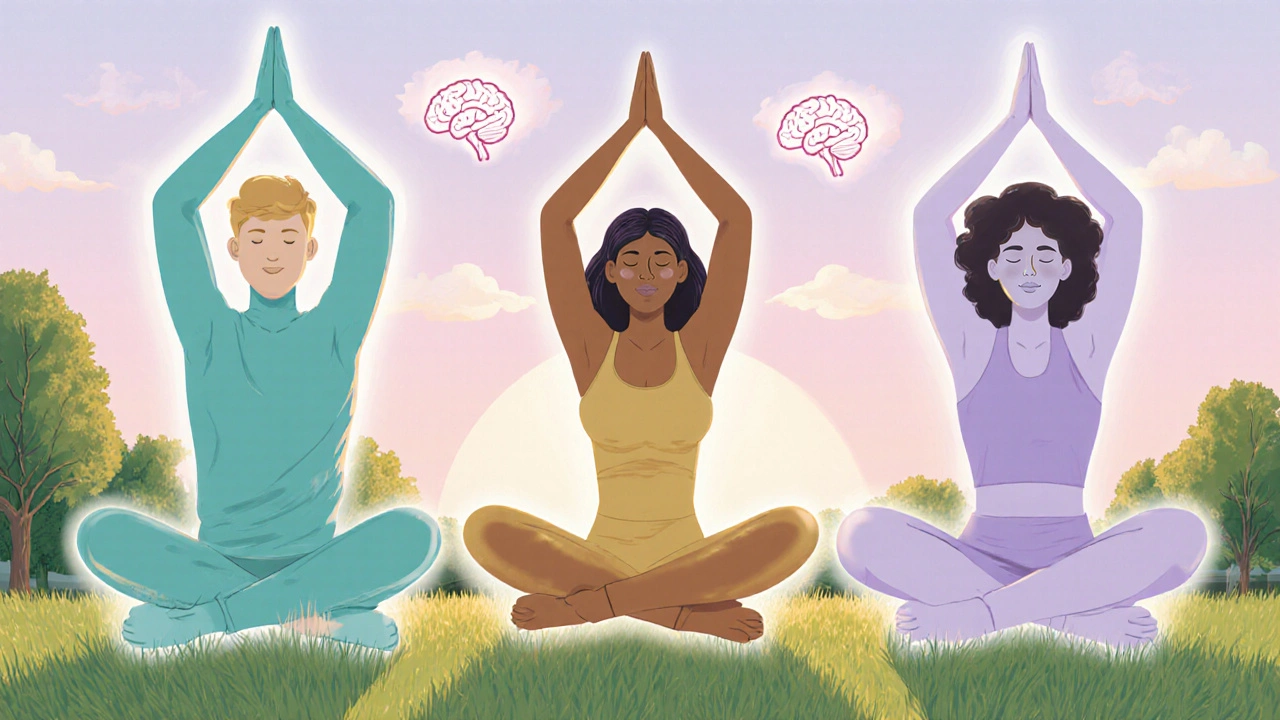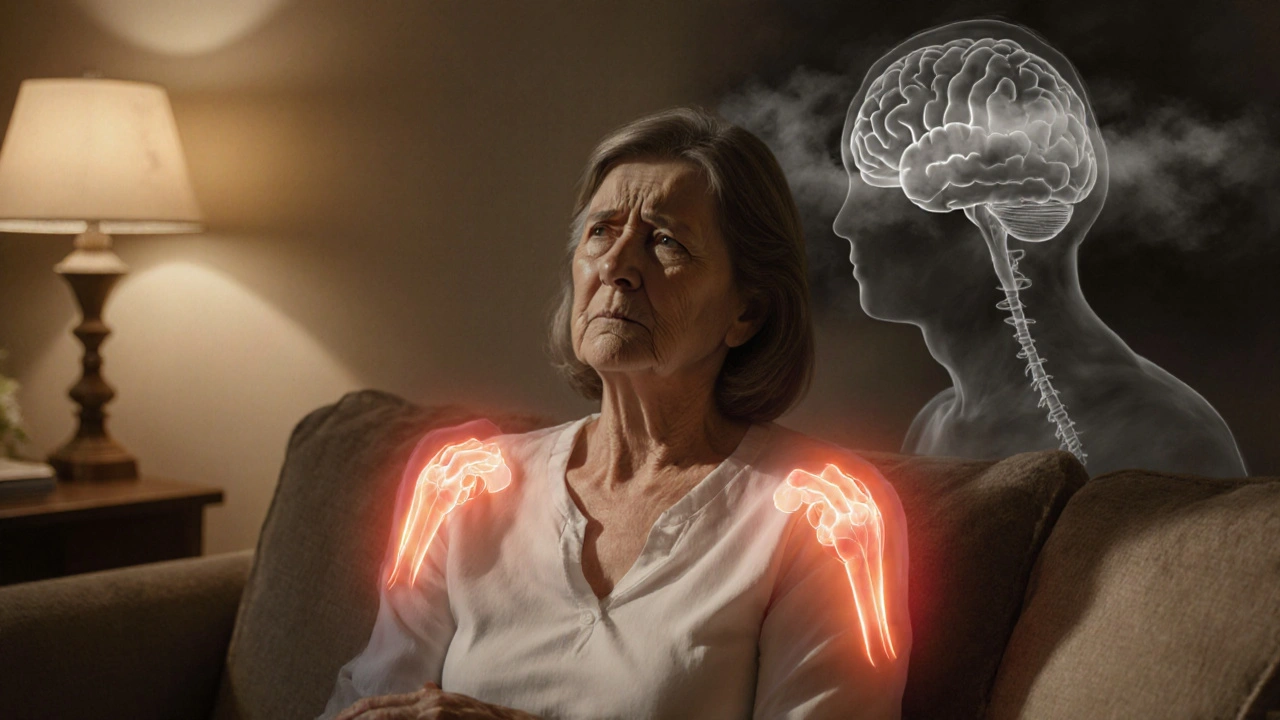Rheumatoid Arthritis is a chronic autoimmune disorder that attacks synovial joints, causing pain, swelling, and gradual loss of function. When the disease flares, most patients notice more than just aching wrists or stiff knees. Mood shifts, sleepless nights, and a feeling of “something’s wrong” often creep in. This article unpacks why the physical battle spills over into the mind, what the science says, and how you can protect both joints and sanity.
What is Rheumatoid Arthritis?
RA belongs to the family of autoimmune disorders, where the immune system mistakenly attacks the body’s own tissues. The culprit is a cascade of inflammatory proteins that erode cartilage and bone. Early signs include morning stiffness lasting over an hour, swollen finger joints, and fatigue that feels like a low‑grade fever.
Clinical tools such as the Disease Activity Score (DAS28) quantify how active the disease is. High scores predict faster joint damage and, as researchers now recognize, a higher risk of mental‑health problems.
Mental Health Challenges in RA
Depression is a mood disorder marked by persistent sadness, loss of interest, and impaired daily functioning. Studies from 2023‑2024 show that up to 40% of RA patients meet criteria for major depressive disorder, nearly double the prevalence in the general population.
Anxiety is a condition characterized by excessive worry, restlessness, and physical tension. Around 30% of those with RA experience clinically significant anxiety, often linked to fear of disease progression and medication side effects.
Both conditions worsen pain perception, reduce adherence to disease‑modifying drugs, and increase health‑care costs. In other words, mental health isn’t a side note-it’s a core component of disease management.
How Inflammation Links to Mood
Inflammation is a biological response involving immune cells, blood vessels, and molecular signals aimed at eliminating harmful stimuli. In RA, the synovium becomes a hotbed of cytokine activity.
Cytokines are small proteins like TNF‑α, IL‑1β, and IL‑6 that coordinate immune responses. Elevated cytokine levels can cross the blood‑brain barrier, altering neurotransmitter metabolism and triggering depressive‑like symptoms. This “sickness behavior” is why a bad flare often feels like a mental slump.
Beyond cytokines, chronic Pain is a sensory and emotional experience that signals actual or potential tissue damage. Persistent nociceptive input sensitizes central pain pathways, fostering a feedback loop where pain amplifies anxiety, and anxiety heightens pain perception.
Fatigue, another hallmark of RA, is not simply a lack of sleep. Fatigue is a profound sense of exhaustion that is not relieved by rest. It intertwines with mood disorders, making everyday tasks feel daunting and eroding self‑esteem.
Managing the Dual Burden
Because the mind and body talk to each other, treating one side without the other leaves a gap. Below are evidence‑backed strategies that address both.
- Optimized pharmacotherapy: Biologic agents (e.g., TNF inhibitors) lower cytokine levels, which can improve depressive scores in addition to joint health. However, corticosteroids, while powerful for flare control, may temporarily worsen mood.
- Psychological interventions: Cognitive Behavioral Therapy is a structured, short‑term talk therapy that modifies maladaptive thoughts and behaviors. Randomized trials show CBT reduces depression by 30% and helps patients stick to medication schedules.
- Physical activity: Low‑impact exercises-swimming, tai chi, or guided yoga-lower systemic inflammation and release endorphins, which lift mood.
- Sleep hygiene: Addressing sleep apnea or insomnia with CBT‑I (insomnia) or melatonin can break the pain‑fatigue‑depression cycle.
- Social support: Joining RA support groups or online forums provides validation and practical tips, buffering against isolation.
When any of these pieces feels missing, talk to your rheumatologist and mental‑health provider together. Integrated care models-where a psychologist sits in the rheumatology clinic-are becoming more common in major health systems.

Comparison: Depression vs. Anxiety in RA
| Feature | Depression | Anxiety |
|---|---|---|
| Typical onset | During prolonged disease activity or after joint damage | Often during flare‑ups or medication changes |
| Core symptoms | Persistent sadness, loss of interest, low energy | Excessive worry, restlessness, muscle tension |
| Impact on pain perception | Amplifies pain, lowers pain tolerance | Heightens vigilance to pain signals |
| First‑line treatment | SSRIs or SNRIs + psychotherapy | SSRIs, benzodiazepine‑sparing CBT, relaxation training |
| Prognosis with proper care | Improvement in 60‑70% within 12 weeks | Symptom reduction in 55‑65% within 8 weeks |
Understanding these nuances helps clinicians choose the right medication and therapy, and it guides patients to self‑advocate for tailored care.
Related Concepts & Next Steps
Beyond the core entities, several adjacent topics deepen the picture:
- Health‑Related Quality of Life (HRQoL): Combines physical, emotional, and social dimensions; RA patients often score lower than those with other chronic illnesses.
- Microbiome‑Immune Axis: Emerging research suggests gut dysbiosis may fuel systemic inflammation and mood disorders.
- Patient‑Reported Outcome Measures (PROMs): Tools like the Hospital Anxiety and Depression Scale (HADS) capture mental‑health status alongside joint assessments.
- Digital Health Apps: Apps that track pain, mood, and medication adherence are proving useful in personalized care plans.
Readers interested in digging deeper can explore topics such as “biologic therapy and depression”, “exercise as anti‑inflammatory medicine”, or “integrated rheumatology‑psychology clinics”. Each thread reinforces the central lesson: treating rheumatoid arthritis without addressing mental health is half‑baked.
Take‑Away Checklist
- Ask your rheumatologist about the mood‑impact of your medication regimen.
- Screen for depression and anxiety annually using HADS or PHQ‑9.
- Incorporate at least 150minutes of low‑impact exercise per week.
- Prioritize sleep - aim for 7‑9hours, and address insomnia early.
- Seek CBT or support‑group resources if mood symptoms linger.
When you address both sides of the equation, you improve joint outcomes, lift mood, and reclaim the daily activities that RA tried to steal.
Frequently Asked Questions
Can rheumatoid arthritis cause depression on its own?
Yes. Chronic inflammation releases cytokines such as TNF‑α and IL‑6, which can cross the blood‑brain barrier and alter neurotransmitter balance, leading to depressive symptoms even in patients without a prior mood‑disorder history.
Is it safe to take antidepressants while on biologic therapy?
Generally, yes. Most antidepressants (SSRIs, SNRIs) have no known adverse interaction with TNF inhibitors or IL‑6 blockers. Always coordinate with both your rheumatologist and psychiatrist to monitor side‑effects and dosage.
How quickly can CBT improve anxiety in RA patients?
Clinical trials report noticeable reductions in anxiety scores after 6‑8 weekly sessions, with continued benefits up to 6 months when patients practice learned coping strategies.
Do NSAIDs affect mood?
Short‑term NSAID use rarely impacts mood, but chronic high‑dose usage can increase gastrointestinal distress and sleep disruption, indirectly worsening depression or anxiety.
What lifestyle changes help both joint pain and mental health?
A combo of regular low‑impact aerobic activity, balanced anti‑inflammatory diet (rich in omega‑3s, fruits, and vegetables), consistent sleep schedule, mindfulness meditation, and strong social connections tackles inflammation, reduces pain, and lifts mood simultaneously.

Julia Phillips
September 27, 2025 AT 01:47When the cytokine storm roars in the joints, it doesn’t stay confined there; it infiltrates the brain’s chemistry, turning ordinary fatigue into a fog of despair.
That emotional weight can feel like a stormcloud hovering over every sunrise, making even simple tasks feel insurmountable.
Recognizing this connection is the first step toward reclaiming both mobility and hope.
Richa Punyani
October 5, 2025 AT 17:47It is essential, therefore, for clinicians to incorporate routine mental‑health screenings alongside DAS28 assessments, ensuring that mood disturbances are identified early.
Patients benefit immensely from a coordinated care plan that addresses both immunologic activity and psychological well‑being.
I encourage healthcare teams to adopt this holistic approach without delay.
Bhupendra Darji
October 14, 2025 AT 09:47Collaboration between rheumatologists and mental‑health professionals can close the gap that often leaves patients feeling abandoned.
Shared decision‑making empowers individuals to understand how their treatment choices influence both pain and mood.
Robert Keter
October 23, 2025 AT 01:47The relentless cascade of TNF‑α, IL‑1β, and IL‑6 in rheumatoid arthritis does more than erode cartilage; it orchestrates a neurochemical symphony that reverberates throughout the central nervous system. As these cytokines breach the blood‑brain barrier, they disturb the delicate balance of serotonin, dopamine, and norepinephrine, sowing the seeds of depressive affect. This biochemical intrusion manifests clinically as a pervasive sense of hopelessness that cannot be dismissed as mere reaction to chronic pain. Moreover, the heightened nociceptive input from inflamed joints amplifies limbic system activity, feeding a vicious feedback loop where pain fuels anxiety and anxiety amplifies pain perception. The phenomenon, often labeled “sickness behavior,” explains why a flare can feel like the world is collapsing into a single, oppressive darkness. Yet, modern biologic therapies that blunt cytokine signaling have demonstrated secondary benefits on mood, with studies showing significant reductions in PHQ‑9 scores after twelve weeks of treatment. Conversely, short‑term corticosteroid bursts, while effective for inflammation control, may temporarily exacerbate irritability, insomnia, and even suicidal ideation, demanding vigilant monitoring. Cognitive‑behavioral therapy, when layered atop pharmacologic intervention, targets maladaptive thought patterns that have become entrenched during prolonged disease activity. Regular engagement in low‑impact aerobic exercise, such as swimming or tai chi, not only lowers systemic inflammatory markers but also triggers endorphin release that counteracts cytokine‑induced neurotransmitter dysregulation. Sleep hygiene, often overlooked, plays a pivotal role; disrupted circadian rhythms can heighten cytokine production, further destabilizing mood. Social support structures, whether through in‑person support groups or moderated online forums, provide a buffer against isolation, a known amplifier of depressive symptoms. Emerging research into the gut‑microbiome suggests that dysbiosis may perpetuate systemic inflammation, offering a tantalizing target for future dietary interventions. Digital health platforms that log pain, mood, and medication adherence empower patients to visualize correlations and advocate for adjustments in real time. Integrating mental‑health professionals within rheumatology clinics streamlines communication, reduces referral delays, and fosters a sense of continuity of care that patients deeply value. Ultimately, addressing both the fire in the joints and the storm in the mind creates a synergistic healing environment, transforming a life once dominated by limitation into one of renewed possibility.
Rory Martin
October 31, 2025 AT 16:47Some industry insiders whisper that hidden agendas steer medication approvals, subtly shaping which drugs reach patients and how side‑effects are reported.
Maddie Wagner
November 9, 2025 AT 08:47Putting mental‑health resources at the bedside can dramatically shift a patient's trajectory, turning despair into determination.
When a therapist sits beside the rheumatologist, the patient sees a united front against both pain and anxiety.
Such integrated care models have already shown lower hospitalization rates and higher treatment adherence.
Boston Farm to School
November 18, 2025 AT 00:47Inflammation’s impact on neurotransmitters is well‑documented 🙂
Tracking mood alongside joint scores can reveal patterns that guide personalized interventions.
Emily Collier
November 26, 2025 AT 16:47From a philosophical standpoint, the mind‑body continuum reminds us that suffering is not compartmentalized; it is a holistic experience.
Thus, assessing emotional distress is as clinical as measuring joint swelling.
Addressing both realms honors the patient’s full humanity.
Catherine Zeigler
December 5, 2025 AT 08:47Every step toward consistent exercise is a victory over both inflammation and the shadows that linger in the mind.
Even modest activities like gentle yoga can elevate endorphin levels, counterbalancing the cytokine‑driven gloom.
Couple this with regular sleep patterns, and you create a rhythm that the immune system respects.
Remember, progress is cumulative; small wins build the resilience needed to face flare‑ups with confidence.
henry leathem
December 14, 2025 AT 00:47From a pathophysiological perspective, the bidirectional neuroimmune axis necessitates a multimodal therapeutic algorithm that transcends monotherapy paradigms.
jeff lamore
December 22, 2025 AT 16:47The clinical community should standardize mood‑screening protocols to ensure no patient slips through the cracks.